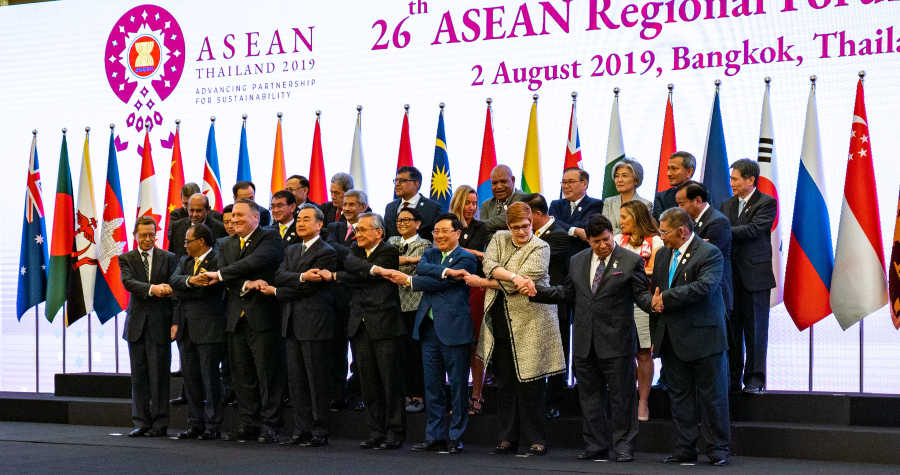How the United States Can Compete With Chinese Influence in Southeast Asia
Promoting regional interdependence through U.S. partners might give Southeast Asian countries more policy independence from Washington, but will also make them more resilient to Chinese influence.

Published by The Lawfare Institute
in Cooperation With

Editor’s Note: China is rising and U.S. influence is declining. Going beyond that vague description is difficult, however, because influence is so hard to measure. Collin Meisel, Jonathan Moyer, Austin Matthews and David Bohl of the University of Denver and Mathew Burrows of the Atlantic Council try to meet this challenge and, in so doing, map how U.S. and Chinese influence has changed over time. Their approach suggests ways the United States can arrest this decline.
Daniel Byman
***
Is China winning the competition for global influence? Answering such a question is difficult, and articles and in-depth studies often focus on a particular country or issue area rather than broader trends.
In a recent report authored by the Atlantic Council’s Foresight, Strategy, and Risks Initiative and the University of Denver’s Frederick S. Pardee Center for International Futures, we analyzed China-U.S. competition using the Formal Bilateral Influence Capacity (FBIC) Index, a quantitative measure of multidimensional influence between pairs of states from 1960 through 2020. As detailed in the report, the FBIC Index attempts to capture the size of interactions, as well as the reliance that one country has on others across economic, political, and security dimensions, in order to gauge the ability of a state to influence in the international system.
Influence capacity is built from two primary components: bandwidth, or the size of the interaction between states, and dependence, or how reliant one state is on the other. As an example, the United States and China have a great deal of bandwidth between one another, particularly given their extensive trade volume, but neither is uniquely dependent on the other as a share of their total economy or security relationships. In contrast, it is common for many smaller Oceanic countries, such as Tuvalu, which often have low-bandwidth relationships due to their size, to be highly dependent on major regional and global powers for their aid, trade, and security relationships.
Trade wars and tariffs are an example of how dependence can be used to exercise influence. In 2020, China had twice the influence capacity over Australia that Australia did over China, as measured by the FBIC Index. So, when Australia restricted foreign investment and banned Huawei from building a broadband network, China imposed sanctions. What followed was a series of Chinese actions aimed to reduce imports of various Australian traded goods, leading to a reduction in exports of $2.3 billion from Australia to China in 2020.
As U.S. policymakers consider how to check China’s growing influence capacity in Southeast Asia, they can avoid being stymied by similar asymmetries in interdependence by leveraging American influence across a broader spectrum of economic, diplomatic and security issues. This approach includes working through close partners that have substantial influence in the region. It also involves reinforcing interdependencies within the region, which will afford countries greater independence and resilience to foreign influence—both from the United States and China, the latter of which will be less able to rely on favorable influence by proxy. If successful, a similar approach could be applied beyond Southeast Asia, balancing Chinese influence through multilateral rather than militaristic and unilateral means.
China-U.S. Competition in Southeast Asia
Globally, China’s rising influence capacity has eaten into long-standing U.S. positions of regional preeminence. In Southeast Asia, where previous bastions of American influence are now characterized by contestation, the transition over the past several decades has been dramatic. As the maps below illustrate, Chinese influence capacity has passed that of the United States in Indonesia and Malaysia—countries where American influence was roughly ten times that of China in 1992, according to the FBIC Index. Collectively, the sum of Chinese influence among member states of the Association of Southeast Asian Nations (ASEAN) now exceeds that of the United States across the entire region.
Eroding American influence: Net US influence, where China’s FBIC Index score in each country was subtracted from that of the United States.
The United States should respond to this growth by leveraging the collective influence of U.S. allies and partners. In Vietnam, for example, South Korea’s influence capacity far outstrips that of either the United States or China and even eclipses Hanoi’s considerable ties with Russia. Washington should count on its partners in Seoul and Tokyo, which also possess considerable influence in Vietnam, to pursue relationships that are ultimately favorable for both states. Should a “Quad Plus” partnership (consisting of the United States, Australia, India, Japan, and South Korea) or “Semi-Quad” partnership (the United States, Japan, Taiwan, and South Korea) come to fruition, the situation is likely to become all the more favorable for American interests.
Additionally, U.S. policymakers should consider influence gains that could be achieved through further integration into multilateral trade partnerships, such as the Comprehensive and Progressive Trans-Pacific Partnership (CPTPP). Though imperfect on labor and environmental issues, the CPTPP or a similar agreement would substantially boost U.S. trade bandwidth with key partners in the Asia-Pacific region. With respect to ASEAN, it would further expand the already substantial U.S. advantage in Singapore and potentially give the United States an economic edge in Vietnam. The U.S.-Japan relationship would be further deepened as well—an important gain given Tokyo’s influence in Southeast Asia and neighboring regions
The United States could further embrace multilateralism and bolster its relationship with Japan by encouraging and sponsoring the expansion of the United States-Australia-Canada-New Zealand-UK “Five Eyes” intelligence-sharing partnership (which presently includes the United States, Australia, New Zealand, Canada and the United Kingdom) to include Japan as a “sixth eye.” This would ensure that the China challenge is being met with a diverse array of tools. Indeed, rather than focusing primarily on securitizing the relationship of the United States and its partners in Southeast Asia and elsewhere, the goal should be to create a balanced network of influence capacity comprised of a diverse set of actors and their economic, political and security-related tools of statecraft.
Increasing regional power through support for regional organizations, such as ASEAN, and their member states could be another key policy priority. Strengthening intra-regional interdependence could allow groups of neighboring countries to gather, identify common interests, resolve disputes and work in a more unified way to counter external influence. While working through an international organization such as ASEAN is not required (though the FBIC Index does posit that shared membership in international organizations itself modestly boosts influence capacity between countries), the formal affiliation of an organization that already “wields real influence” provides a forum to gather and develop further internally coherent policies and responses to external partnerships.
As evidence of this regional organization strategy, measured collectively, the sum of influence capacity that ASEAN member states have between one another vastly exceeds that which the United States or China possess individually across these states. If ASEAN can improve its ability to facilitate collective action, it could more effectively resist efforts by external powers to achieve dominance over their regional security and economic linkages, becoming more regionally autonomous and assertive of member interests.
Stronger together: The sum of ASEAN member-nation influence within ASEAN far exceeds that of China or the United States, though average ASEAN member-nation influence remains low.
While a more interdependent ASEAN could also counter U.S. influence efforts in the region, it could be a more significant hurdle to China’s influence efforts in its immediate neighborhood. Rather than seeking to directly compete for influence with China one-on-one, which would probably be a losing endeavor in most of ASEAN, the United States should aim to collaborate with influential allies—most notably Japan and South Korea—and help the region develop its own strong internal interdependencies. Although a gamble, this strategy would work within the bounds of U.S. capabilities and counterbalance China, all while helping strategic partners to grow their own independent strengths.
To be sure, this approach comes with a unique set of challenges, namely those that involve bridging the divide between states’ varying perceptions of the extent and severity of the challenge that China poses to their respective national interests and its associated costs. The costs of opposing China for South Korea, for example, have the potential to be much higher and the threat of retaliation much closer to home than for the United States. This fact was recently evidenced by China’s retaliation against South Korea’s hosting of an American Terminal High-Altitude Area Defense (THAAD) battery. According to one estimate, THAAD-related Chinese sanctions cost Seoul roughly $7.5 billion, including trade and tourism losses, as of November 2020.
With heavy reliance on China for both imports and exports, Japanese leaders must also carefully weigh the costs of a tougher stance against China. The onus is on the Biden administration to demonstrate to Tokyo that the long-term benefits of collective action to counterbalance Chinese influence are greater. So too must the administration make clear to ASEAN leaders that its goal is not to have member states choose sides but to diversify dependencies within the region and empower them to act more independently.
Beyond Southeast Asia
Although our recommendations focus on one region, Southeast Asia, our work indicates that the story is the same in virtually every region in the world: China’s rapid and substantial rise translates into a relative, though not necessarily absolute, decline in U.S. influence capacity.
U.S. policymakers can manage these changing dynamics by tailoring foreign policy to leverage specific elements of influence where the United States maintains an advantage. At the core of this strategy is leveraging, or perhaps simply relying upon, the influence of partners.
By contrast, a unilateral approach is likely to fail. In the Middle East and North Africa, where unilateralism has been the standard U.S. strategy for decades, public opinion has tilted heavily in China’s favor. Combined with the effects of resurgent Russian and expanding Iranian influence, the “American era” in the Middle East has ended. If the United States chooses unilateralism in Southeast Asia, it could be next.









